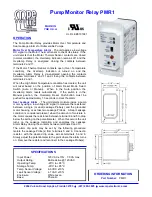
Automation Components, Inc.
2305 Pleasant View Road | Middleton, WI 53562
Phone:
1-888-967-5224 |
Website:
workaci.com
Page 2
Version: 1.0
I0000467
NC
C1
NO
NC
C1
NO
A
1
F
A
J2
F
24
12
0-20mA
J1
IN
-
+
H1
L1
H2
L2
2
NC
C1
NO
NC
C1
NO
A
1
F
A
J2
F
24
12
0-20mA
J1
IN
-
+
H1
L1
H2
L2
2
Snap together to extend signal and power
Analog
Input
Signal
(+)
(-)
24 VAC/DC
Power Supply
(+)
(-)
24
12
0-20mA
J1
24
12
0-20mA
J1
0-20mA
0-12V
24
12
0-20mA
J1
0-24V
Signal Input Ranges
Set Jumper Switch for
A
1
F
A
J2
F
2
Relay 1
Relay 2
FIGURE 2:
WIRING
Calibration
1. Each relay can be individually set for a Fixed or Adjustable deadband. Place jumper shunts for relay 1
or 2 on A for adjustable or F for fixed (or a combination of each).
Example:
Relay 1 is set for an adjustable deadband. The turn on level is set with the High (H1)
potentiometer. The turn off level is set set wit the Low (L1) potentiometer (see Figure 2 for locaion of H1
and L1).
Relay 2 is set for a fixed deadband, which allows a deadband of 3% of the input signal between the turn
on and turn off signal levels. Use the Low (L1) potentiometer to set the turn off level of the fixed
deadband (the High potentiometer is out of the circuit).
2. Three input signal ranges can be selected. Set J1 to the desired type.
Note:
If the first board is to receive a 0-20 mA signal, then any attached boards must be set at the 0-12
VDC signal mode to operate correctly.
If the input signal is voltage, then set attached boards to same voltage as the first board. Up to 6 boards
may be cascaded from same power supply. More can be connected if external power connection is
jumpered to every sixth board.
3. After jumpers are placed in the desired setting, turn on 24 volt power supply.
4. Turn all four potentiometers counterclockwise (these are approx. 20 turn pots).
5. Provide an input signal level equal to the desired turnoff point.
6. Adjust the L (low) potentiometer clockwise until the LED for the relay just turns OFF.
7. Turn the H (high) potentiometer for the relay clockwise (these are approx. 20 turn pots).
8. Provide an input signal level equal to the desired turn-on point.
9. Adjust the H potentiometer counterclockwise until the LED for that relay just turns ON.
10. Repeat steps 5 through 9 for each relay.






















